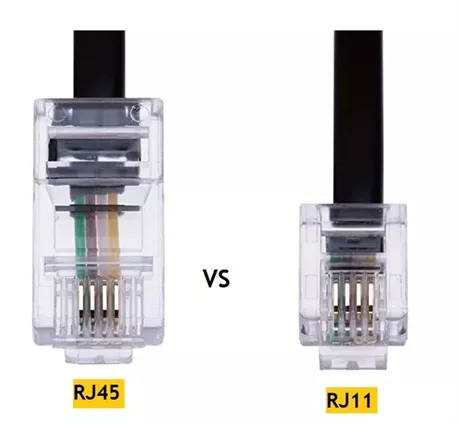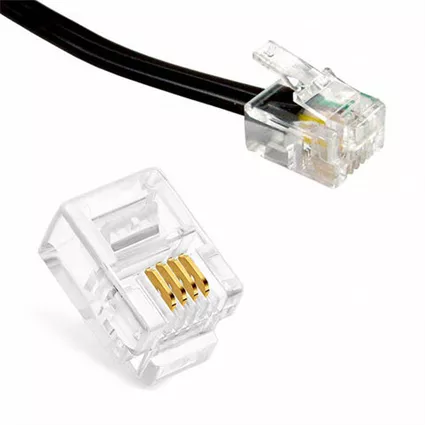Ever heard of the humble RJ11 connector? It's that little plastic plug you might find on the end of your landline phone cord, the unsung hero of communication before Wi-Fi took over. But why might you use an RJ11 connector? Go ahead.

What Is An RJ11 Connector
An RJ11 connector is a standardized telecommunication connector that is typically used for connecting a telephone or fax machine to a wall outlet. It is a 6-position, 4-conductor connector, meaning that it has six contact points, but only four of these are typically used for a typical phone line connection.
RJ11 connectors are frequently found in homes and offices. They are smaller than the similar-looking RJ45 connectors, which are commonly used for Ethernet connections. RJ11 connectors are essential for establishing a physical connection between your telephone or fax machine and the telephone line provided by a telecommunication company.Each of the four wires within an RJ11 cable serves a specific purpose in transmitting audio signals for voice communication.

Why Might You Use An RJ11 Connector
You might use an RJ11 connector for various reasons, including:
-
Telephone Connection: The most common use of an RJ11 connector is for connecting a telephone to a wall outlet or a telephone line. The RJ11 connector allows you to establish a wired connection between your telephone device and the telecommunications network.
-
Fax Machine Connection: RJ11 connectors are also used to connect fax machines to phone lines for sending and receiving faxes. Fax machines typically use RJ11 connectors to establish a communication link with the telephone network.
-
Modem Connection: RJ11 connectors are commonly used to connect modems to telephone lines for internet access, particularly in situations where DSL (Digital Subscriber Line) internet service is used. The RJ11 connector facilitates the transmission of data between the modem and the telephone line.
-
Alarm System Connection: Some alarm systems, particularly older models, use RJ11 connectors to connect to a landline phone system for alert notifications or monitoring purposes.
-
POS Systems: Point of Sale (POS) systems in retail environments may also use RJ11 connectors to connect peripherals such as credit card readers or cash drawers to the central system.
Overall, RJ11 connectors are essential for establishing physical connections in telecommunications for various devices such as telephones, fax machines, modems, and other equipment that rely on phone lines for communication.
Differences Between The RJ11 And The RJ45
RJ11 and RJ45 connectors are both widely used in networking and telecommunications, but they serve different purposes and have distinct characteristics. Here are the key differences between RJ11 and RJ45 connectors:
-
Physical Size and Number of Pins:
- RJ11: An RJ11 connector is smaller and has 6 positions with 4 conductors. It is commonly used for connecting telephones, fax machines, and modems to a telephone line.
- RJ45: An RJ45 connector is larger and has 8 positions with 8 conductors. It is primarily used for Ethernet networking and connecting computers, routers, switches, and other network devices.
-
Applications:
- RJ11: Typically used for voice communication, telephone lines, fax machines, and analog modems.
- RJ45: Primarily used for data networking, connecting devices to local area networks (LANs), routers, switches, and other Ethernet-enabled devices.
-
Number of Conductors:
- RJ11: Has 4 conductors (wires) used for transmitting voice signals.
- RJ45: Has 8 conductors (8 wires) used for transmitting data in Ethernet networks. Each wire serves a specific purpose in data transmission.
-
Compatibility:
- RJ11: Not compatible with RJ45 ports and vice versa due to differences in size and pin configurations.
- RJ45: Compatible with RJ45 ports, allowing for standardized connections in Ethernet networks.
-
Speed and Data Transmission:
- RJ11: Designed for lower data speeds suitable for voice communication (e.g., phone calls, faxes).
- RJ45: Designed for higher data speeds required in Ethernet networks, supporting various data rates including 10/100/1000 Mbps (Gigabit Ethernet) and beyond.
-
Color Coding:
- RJ11: Typically uses only 2 pairs (4 wires) out of the 6 available positions and may have different color coding schemes based on the application.
- RJ45: Utilizes all 8 conductors and follows specific color coding standards such as TIA/EIA-568 to ensure proper connectivity in Ethernet networks.
In summary, RJ11 connectors are smaller, have fewer conductors, and are used for voice communication and low-speed data transmission, whereas RJ45 connectors are larger, have more conductors, and are primarily used for Ethernet networking and high-speed data transmission.
|
Purpose |
RJ45 |
RJ11 |
|---|---|---|
|
Purpose |
Primarily used for computer networking like connecting devices to routers or modems. |
Primarily used for telephone lines and other low-voltage applications like DSL modems and fax machines. |
|
Appearance |
Larger, with eight positions for wires. |
Smaller, with four or six positions for wires. |
|
Wires |
Typically has eight wires, used for transmitting and receiving data over multiple channels. |
Typically has four wires, often green and red for the two signal paths. |
|
Wiring Standards |
More complex wiring standards like TIA/EIA-568-B for different network configurations. |
Two main standards, T568A and T568B, for how to arrange the wires. Both ends of the cable must use the same standard. |
|
Compatibility |
Some RJ11 plugs can fit into an RJ45 jack, but functionality might be limited. |
An RJ45 plug is too large to fit into an RJ11 jack. |
Cautions For Using An RJ11 Connector
When using an RJ11 connector, especially in telecommunication setups for connecting phones, fax machines, modems, or other devices to a telephone line, it's important to keep a few cautions in mind to ensure proper functionality and prevent potential issues:
-
Correct Wiring: Ensure that the RJ11 connector is wired correctly. Mistakes in wiring, such as reversing the polarity of the wires, can lead to connectivity issues and affect the quality of voice communication or data transmission.
-
Avoid Bending or Pinching the Cable: Do not excessively bend, pinch, or tug on the RJ11 cable. Physical damage to the cable can degrade signal integrity and cause connectivity problems.
-
Protect from Moisture and Dust: RJ11 connectors are sensitive to moisture and dust. Keep the connectors and cables away from water sources, humid environments, and dusty areas to prevent corrosion and signal interference.
-
Avoid Overloading Line: When using an RJ11 connector for telephone lines, avoid overloading the line with too many devices connected in parallel. Excessive devices on the same line can lead to signal degradation and affect call quality.
-
Properly Secure Connections: Ensure that the RJ11 connector is securely plugged into the socket. Loose connections can introduce noise, interference, or cause intermittent disconnections.
-
Use Quality Cables and Connectors: Invest in high-quality RJ11 cables and connectors to ensure reliable connections and longevity. Low-quality cables can lead to signal loss and poor audio/data transmission.
-
Check Compatibility: Make sure the RJ11 connector is compatible with the device you are connecting. Using an incompatible connector can damage the device or lead to connectivity issues.
-
Avoid Overstretching Cables: Do not excessively stretch or pull on RJ11 cables. This can damage the cables, cause breakage, and impact the signal quality.
-
Regular Inspection: Periodically inspect the RJ11 connectors and cables for any signs of wear, damage, or corrosion. Replace any damaged components to maintain optimal performance.
By following these precautions and best practices, you can ensure the reliable performance of your RJ11 connector setups and reduce the risk of connectivity issues or potential damage to connected devices.



